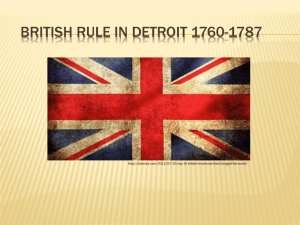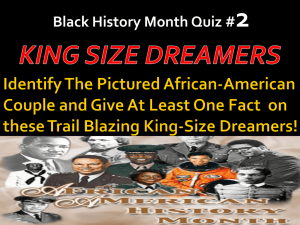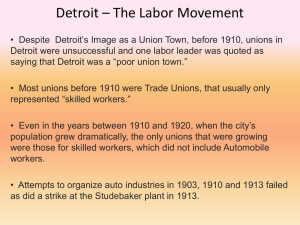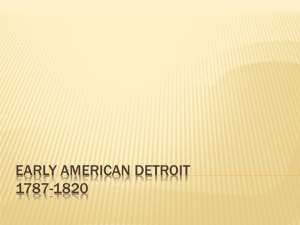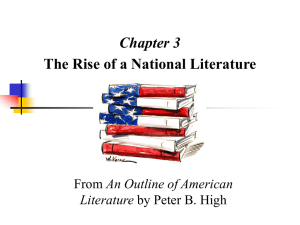Louis Phelypeaux (Count Pontchartrain)
advertisement
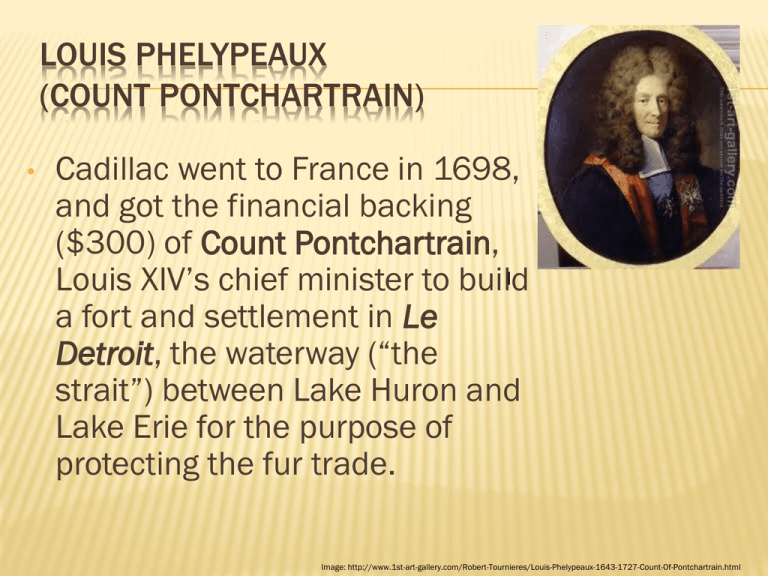
LOUIS PHELYPEAUX (COUNT PONTCHARTRAIN) • Cadillac went to France in 1698, and got the financial backing ($300) of Count Pontchartrain, l Louis XIV’s chief minister to build a fort and settlement in Le Detroit, the waterway (“the strait”) between Lake Huron and Lake Erie for the purpose of protecting the fur trade. Image: http://www.1st-art-gallery.com/Robert-Tournieres/Louis-Phelypeaux-1643-1727-Count-Of-Pontchartrain.html JULY 24, 1701 • • • • Cadillac founded Detroit with 100 men near present day Cobo Hall. Built Fort Pontchartrain in his honor. Built churches, schools, and hospitals. Fort Pontchartrain was 200 feet long and 200 feet wide with a 12 foot high wooden palisade Cadillac encouraged Indians to move from Michilimackinac to Detroit to trade, and intermarry with the French to win allies. By 1704, there are 2,000 Indians near the fort. Cadillac’s wife gave birth to first European child in Detroit, Marie Therese Cadillac. FORT PONTCHARTRAIN DU DETROIT http://historydetroit.com/places/fort_ponchartrain.php The southern border was present day Jefferson Avenue. The northern border was between present day Larned Street and Jefferson Avenue. The eastern end was where Griswold Street is today. And the western border was along present day Shelby Street. http://www.detroit1701.org/Graphics/2005/Otober2005/Completed/FortPontchartrainMarker.JPG THE PONTCHARTRAIN HOTEL 1907-1920 http://wewastetime.com/2012/03/21/ “The Pontch” was the first major hotel in Detroit since the 1920s 1965 – Present http://www.freep.com/article/20120403/NEWS01/120403042/Detroit-s-Pontchartrain-Hotel Later became the Crowne Plaza Detroit Pontchartrain, then Sheraton Detroit Riverside, then Detroit Riverside Hotel. Now it’s the Crowne Plaza Pontchartrain Detroit again. WHY CHOOSE DETROIT? • • • • River is narrow and no islands between Bank was forty feet high, so could occupy high ground First building was Ste. Anne de Detroit Church, the second oldest continuous parish in the United States. Ste. Ann was the patron saint of New France. The first priest of Ste. Anne was killed during a skirmish with local Indians in 1706 after a dog bit an Ottawa. Ste. Anne’s Church moved to what is now Mexicantown in Southwest Detroit in 1818. The church pictured here was built in 1887. http://en.wikipedia.org/wiki/Ste._Anne_de_Detroit_Catholic_Church FRENCH RIBBON FARMS • • • • To encourage French settlement around Fort Pontchartrain, Cadillac (a seigneur) gave land grants (called ribbon farms) to 75 settler families (called habitants) starting in 1707. Some of the street names between the river and Jefferson Avenue are the owners. Ribbon farms fronted the river, but were only 200-600 feet wide, and 1.5 - 3 miles long He ruled as a lord in a feudal system, and made many enemies among the habitants with his annual tax. Grain had to be ground at Cadillac’s mill, and Cadillac received a percentage of the grain. Habitants had to work a certain number of days on Cadillac’s own farm. French ribbon farms were on both sides of the Detroit River French Ribbon Farms Belle Isle Fort Pontchartrain http://en.wikipedia.org/wiki/Ribbon_farm CADILLAC’S RULE • • • • • • Missionaries did not like Cadillac because he gave alcohol to the Indians, and cared more about fur trading than converting Indians to Christianity. Overcharged for liquor (7x the price in Montreal) “Generally hated by all the French and Indians.” During his reign, he was charged with abusing his authority and trafficking in alcohol and fur. Count Pontchartrain said he displayed “too much greed,” and he was reassigned to be the governor of Louisiana in 1710. One historian called him “one of the worst scoundrels ever to set foot in North America.” http://en.wikipedia.org/wiki/Ribbon_farm QUEEN ANNE’S WAR (1702-1713) • • • Second of four English-French conflicts in Europe that spilled over to the New World Few French came to New France, and nonCatholics were not allowed. Unlike the English colonies, no other nationalities were allowed to emigrate. Cadillac tried to make Detroit an agricultural center of the West, but it remained a fur trading center. In 1720, only about 200 people. THE FOX INDIAN MASSACRE (1712) http://www.gphistorical.org/legends04.html Part of Queen Anne’s War Only battle ever fought in Grosse Pointe (then called Presque Isle by the French) 1,000 Fox and Mascoutin Indians move to Detroit from Wisconsin, and the new commander, Dubuisson, tries to remove them, causing warfare that lasted until 1734. Fox Indians attack fort for 19 days. As the Fox retreat, Huron and Ottawa Indians, allied with the French, killed more than 1,000 Indians, allied with the English, in what is now called Windmill Pointe area (near the Grosse Pointe/Detroit border) WHAT HAPPENED TO CADILLAC? Cadillac finally arrived in Louisiana in 1713. He wanted to found a city at the mouth of the Mississippi, but was refused. New Orleans was later founded in 1718. Cadillac explored the present-day Missouri area in 1715, and ordered the first mining of lead for ammunition (still a major resource today) by African slaves. In 1717, he went back to Paris, and in 1722, he was appointed governor of a region in France. Died in 1730. FORT MICHILIMACKINAC - 1715 Inspired the French to build Fort Michilimackinac in 1715, in present day Mackinaw City, to replace Fort de Buade in St. Ignace. 1713-1743 – Relative peace between France and England, but Detroit’s population grew slowly (only 2,000 by 1760). French established 11 posts in the Great Lakes (3 in Michigan: Pontchartrain (1701), Michilimackinac (1715), St. Joseph (1691)). Images: http://www.mightymac.org/michilimackinac.htm KING GEORGE’S WAR (1744-1748) Third of four English-French conflicts in Europe that spilled over to the New World French send 150 soldiers from Montreal, and start to encourage more French settlement in Detroit, which remains small (900 in 1749). French foil small conspiracy of British and Iroquois to attack Detroit British (since 1707, called British, not English) start incursions into Ohio Valley British Navy was able to disrupt French trade to Montreal, exposing French weakness. FRENCH AND INDIAN WAR (1754-1763) Final English-French conflict in Europe (Seven Years War) that spilled over to the New World British and France both claimed the Ohio Valley including future states of Ohio, Indiana, Illinois, Wisconsin, and Michigan French, allied with Indians, fought against the British for control of fur trade and prevent British farmers from clearing the land (“fur trade vs. farming”) 1.5 million British vs. 50,000 French GEORGE WASHINGTON AND THE START OF THE FRENCH AND INDIAN WAR • • • Governor Dinwiddie of Virginia sent surveyor George Washington and 150 militia to get the French to leave the future Pittsburgh area. British Colonists started the war, not the Crown, because they saw the French and Indians as blocking their expansion westward. Gen. Edward Braddock (British) and Washington tried to take Fort Duquesne (named for Marquis Duquesne, the governor of New France), but failed in 1755. Braddock was killed. Michigan native Charles Langlade led Ottawa and Chippewa warriors to defend the fort. https://www.watchmenpastors.org/lost-episode-for-july-18/ http://www.superstock.com/stock-photos-images/1899-20457 • No picture of Langlade exists http://www.rootsweb.ancestry.com/~wilchs/lchistory.htm Pitt: http://en.wikipedia.org/wiki/William_Pitt,_1st_Earl_of_Chatham WILLIAM PITT • • • • British political leader of French and Indian War 1758 – British captured Fort Duquesne, and renamed it Fort Pitt (and Pittsburgh). British promised the Indians that the land west of the Appalachians would be reserved for them. 1759 – Three French forts fell Sept. 13, 1759 – British Gen. James Wolfe defeated French General Marquis de Montcalm in the Battle of Quebec. Both died. Wolfe http://freemasonry.bcy.ca/biography/wolfe_j/wolfe_j.html Montcalm http://clementeocheduval.blogspot.com/2011/10/la-chute-de-la-nouvelle-france-la-perte.html THE DEFEAT OF THE FRENCH • • Sept. 1760 – French surrender to British General Jeffrey Amherst in Montreal. Nov. 29, 1760 – Detroit under Major Robert Rogers surrenders, and becomes British (Fort Detroit) under Captain Donald Campbell. Campbell instituted Lord Amherst’s order to reduce gifts to the Indians, and forbade the sale of alcohol to the Indians Sir William Johnson, a friend of the Iroquois, opposed Amherst’s policy of no gifts, fearing it would spark an Indian war The war in Europe continued until 1763, so many French stayed in Detroit area after 1760 Amherst http://www.history.org/foundation/journal/spring04/warfare.cfm • • http://www.livinghistoryed.org/RogersRangersCourse.htm Robert Rogers led British forces during the war called “Roger’s Rangers.” Like Charles Langlade, he used guerrilla warfare tactics, even creating 28 “rules of ranging” still used by Army Rangers today
